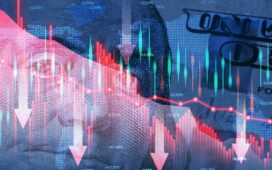Tariffs or no tariffs, you need a core holding to carry you through the next 30 years. Our sortable scorecard of 52 Best Buys will take you to it.
Buy the dip? That takes some fortitude, when world trade is on the verge of collapse, consumers are frightened and businesses can’t plan anything. The U.S. stock market, as measured by the Vanguard Total Stock Market fund, sank a convulsive 5% yesterday.
But don’t see the crash as a buying opportunity, or as a selling opportunity either. Take it as a reminder that your stock portfolio is a long-term asset. Your horizon should be 30 years. You should be aiming to get a piece of the profits corporations will be making in the year 2055. Today’s political antics will be long past.
Picking individual stocks can provide entertainment, and it’s okay to do that with 10% of what you have in the market. Approach this activity with humility. If you have the insight that tariffs will hurt apparel companies, someone else had the same insight ahead of you, and you’ll be selling VF Corporation after it is already down 29%. European drug companies look like buys? Too late. GSK is already up 3.6%.
The other 90% of your equity money should be in a fund. There are 11,460 choices, including all the weird share classes. Use this guide to speed the search.
The table displays 52 Best Buys, all of them exchange-traded, meaning they can be bought and held at any brokerage. The list is sortable, so that you can select for the attributes you want. Click on column heads to get just large companies or get all of them, to invest with a social conscience or not, to aim for dividend-heavy portfolios or not.
Whatever your choices on those fronts, there are two things that you should always care about. A stock ETF should be big and it should be cheap.
Big, so that you can be reasonably confident it won’t go out of business and so you can trade in and out without getting killed by the bid/ask spread. All of the Best Buys are big. They have at least $1 billion of assets and see at least $1 million a day of trading volume.
Cheap, so that your savings don’t get eroded. A competitively priced ETF covering the U.S. stock market will have an annual expense burden no heavier than 3 basis points (0.03%, which is to say, $3 a year for every $10,000 invested). You might pay somewhat more to get something you want badly, such as a portfolio excluding the stocks of wicked corporations, but you shouldn’t pay a lot more.
Some funds earn back a bit of their fees by lending shares to short-sellers. The lending revenue is meaningful only in portfolios that include flaky small companies. At the largest fund, Vanguard Total Stock Market, securities lending recovers for shareholders roughly 1 basis point out of Vanguard’s 3-basis-point fee.
This fund finder includes the best options in several categories of U.S. stock funds. Where there are lots of products clamoring for your attention (how many S&P 500 funds does the world need?), the table selects only a few, favoring those with low expenses, high assets and high trading volumes.
Here are some things to contemplate when investing.
1. How big are transaction costs?
The going commission rate on trading shares of anything, including shares of ETFs, is $0. Your round-trip cost, then, is indicated (but not precisely determined) by the spread between the buying price (“ask”) and what you get when you sell (“bid”). The spread might be to 1 to 3 basis points for a very active ETF, or 6 to 10 basis points for one of the sleepier funds on our table.
Transaction costs, then, are not big over the course of a 30-year holding period. Yes, that should be your time frame. At age 40 you are saving for retirement, at 70 for your grandchildren.
2. How big are taxes?
This is not a consideration for someone buying in an IRA or 401(k).
For those buying a total stock market ETF in a taxable account, the news is fairly good. A typical tax rate on dividends (federal base rate, plus federal investment tax, plus state tax) would be something like 25%. Multiply that by the 1.2% dividend yield on such a fund and you have 30 basis points of annual damage.
What about capital gain taxes? Unlike mutual funds, which regurgitate capital gain dividends onto helpless shareholders, stock ETFs rarely distribute taxable gains. You pay tax on appreciation in the fund shares only when you sell. Leave them to your grandchildren and the appreciation is never taxed.
3. Does past performance matter in an index fund?
No. It doesn’t tell you anything.
4. I’m retired. Should I go for one of the dividend ETFs?
The table includes a few dividend-happy funds because they are in great demand. But trying to boost your yield is kind of stupid.
In an IRA, a high dividend is harmless. In a taxable account, it causes needless damage, and there is no need for it as a source of cash to spend.
If you want to spend 3% of the portfolio, and you are investing in a taxable account, don’t reach for yield. Buy a fund yielding 1.2% and cash in 1.8% of the shares every year.
5. What is tracking error?
Tracking error is the discrepancy in returns between an index fund and the index it’s tracking. Fund watchers with too much time on their hands get worked up about tracking errors. But these fluctuations don’t matter. What matters is drag, a chronic shortfall.
A fund that beats its index by 47 basis points one year, then falls behind by 53 the next, has a big tracking error, but its drag is only 3 basis points. (The primary determinant of drag is the expense ratio, although index revisions and securities lending can affect it.) Drag is what determines how well you will do over 30 years.
A fund that beats its index by 2 points one year, then loses by 26 points the next, has a smaller average tracking error than the plus 47 / minus 53 fund. But it’s a worse buy. Its drag averages 12.
Ignore the tracking error. Watch the drag. That means watching the expense ratio.
6. Do factor funds beat the market?
Sometimes, yes. Overall: probably not.
Factors became quite the fad a few years ago. See Six Magic Potion Funds From Vanguard.
The idea is that some attribute discernible from financial statements is a marker of future performance. Among the factors that seemed to work, at least when you looked backward: quality (a combination of balance sheet strength and high and steady profit margins), low volatility (in share prices) and momentum (recent favorable price action).
One of the factors Vanguard offered for sale in 2018 was low liquidity. Thinly traded stocks supposedly would have to reward long-term holders for tolerating low liquidity. So you would buy the fund, hold patiently for a few decades and retire rich.
For investors who can’t resist the allure of a beat-the-market scheme, our table offers, reluctantly, factor funds in a few different flavors. These at least have the virtue of keeping their management fees low.
But before you dive in, try this experiment. Go to Vanguard.com and put into its search box VFLQ, the ticker for that low-liquidity fund. No results. The fund must have been liquidated. One surmises that the performance was disappointing.
There is a lesson here, not just about Vanguard, which is on the whole an honorable and straight-shooting money manager, but about all of Wall Street. The products on display are not representative of investor experience. Disappointing funds get memory-holed.
7. What happens in the air space between the bid and the ask?
Late on April 3, a day when its trading volume was double the norm, Vanguard’s Total Stock Market ETF was quoted on Morningstar at $264.28 bid, $264.32 ask. If we presume that, at that moment, the true value of the portfolio was $264.30, then either a buyer or a seller was coughing up 2 cents a share to a middleman. The round trip friction would be 4 cents, or a bit more than 1 basis point.
However, it’s quite possible that 1 basis point understates the damage done to small-fry investors like you. To see why, call ticker VTI up on your brokerage screen and refresh every few seconds. You’ll see the price jump up and down 4 or 8 cents. So what happens during the interval between when you submit a trade and when it gets executed?
Put in a market order for a buy and you’ll probably get execution during a momentary uptick. Put in a market sell and maybe the trade happens to occur a few milliseconds later, when the market has turned bearish and the price is down a few cents. The effective real-world bid/ask spread might be wider than the 4 cents visible at any snapshot in time.
High-frequency traders are at work here. They are not in business for their health.
Would a limit order protect you when you’re moving 400 shares of VTI? Probably not, although it might be useful if you’re investing in a more thinly traded fund with a 30-cent bid/ask spread.
Suppose you submit a buy for VTI at $264.30, meaning you won’t pay a cent more, or a sell with that limit, meaning you won’t accept a cent less. A middleman will only execute the trade if it suits his interests. The distinct possibility is that your limit order will be executed if and when the market is whooshing past your price, otherwise ignored. You think you are getting into the middle of the spread, but in reality you are not.
Who’s running the computers in the middle? Any hedge fund or investment bank with an ability to do some complicated hedges is in a position to jump into the fray. But the prime suspects in the case of the Vanguard Total Stock Market fund are the 15 entities that have been creating and redeeming shares of this fund. (Creation and redemption are necessary only on days when buyers greatly outnumber sellers, or vice versa.) One of those “authorized participants” is Citadel Securities, which shows up in a Securities & Exchange Commission filing with $5.3 billion of VTI creation work last year.
Be thankful for the middlemen. The 1 or 3 basis points they peel out of your wallet is a tiny fraction of the trading cost investors incurred in olden times, when stocks traded in eighths and commissions were fixed.
But don’t feel sorry for these market makers, either. Citadel’s main owner is a guy who, when shopping for a pied-à-terre in Manhattan, had $238 million of spare change for the purpose.
8. When is the best time to trade an ETF?
Near the opening and closing bells, pricing can be chaotic, creating more opportunity for middlemen to snatch a few extra cents a share. Better times to submit an order: 10 a.m. or 3 p.m.





